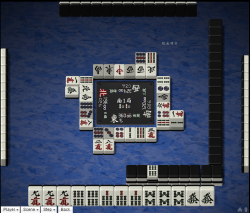Furiten: Difference between revisions
(causes-consequences reformulation) |
|||
| Line 20: | Line 20: | ||
|tilerow2 = 23p3s6z4s1m | |tilerow2 = 23p3s6z4s1m | ||
|tilerow3 = 4z | |tilerow3 = 4z | ||
|source = | |source = 2-pin in this discard applies furiten to the example hand | ||
}} | }} | ||
Revision as of 10:59, 26 August 2013

Furiten, meaning sacred discard, is a hand status. A player in tenpai is furiten if he could win on an earlier self-discarded tile, or if he has recently ignored to win by ron. Players in furiten may still win by tsumo, but not by ron.
Consequences
Players in furiten may not win by ron, even if they have a yaku. Declaring ron while in furiten is penalized with a chombo payment.
Players in furiten may still win by tsumo.
Causes
A player in tenpai is furiten if at least one of the conditions listed below applies.
Discard-based furiten
A player is furiten if a winning tile is present in his own's discard pile. It does not matter whether this tile would have provided a yaku or not. Tiles turned sideways within open melds are considered part of their discarder's discard pile.
As long as the player has not declared riichi, furiten can be avoided by altering the hand and changing tile waits.
This hand waits on three different tiles. If the player has a 2-pin in his own discard pile, he is furiten and may not win by ron on any tile. Even if a 5-pin or 8-pin gets discarded by an opponent, he may not call ron.
Permanent furiten during riichi
A riichi declarer may ignore a winning tile and not call ron. The ignored tile may have been a discarded tile or a tile used to extend a minkou to a shominkan.
After ignoring a winning tile, the riichi declarer is permanently furiten for the rest of the hand.
Even if a winning tile different from the ignored one appears, the player may not call ron. This rule requires knowledge of all own possible waits.
The idea behind this rule is that all tiles discarded by any player after the riichi declaration are deemed safe tiles. Riichi declarers may not decline a ron against one player and expect to declare ron against another.
Temporary furiten
A tenpai player who has not declared riichi may also ignore a winning tile.
The player then becomes temporarily furiten until his next own discard. Some rules additionally cancel temporary furiten on any tile call by any player.
The furiten rule does not consider yaku. Sometimes, a hand can be completed with several tiles, but only some of them provide a yaku, others would produce a yakuless hand. If a yakuless tile appears, it must be ignored, because a winning hand must contain a yaku. The player must remain temporarily furiten.
This rule makes it harder to target a specific player with ron, or to ignore a winning tile of lesser value and hope for a tile giving more yaku.
Strategy
Defense
The furiten rule may be applied for defensive play, which focuses on discarding safe tiles. By discarding tiles that are also visible in an opponent's discard pile, a player can avoid a ron call by that opponent. Likewise, usage of suji and kabe may also help players deduce safe tiles, based on opponent discard. This is applied when a player does not have any matching tiles in the hand with opponent discard; or a player may rather keep certain tiles, for the sake of developing the hand without tearing it apart.
Dealing with furiten
Sometimes, it may be necessary to deliberately place the hand in furiten. Often, this is the result of developing the hand and defending simultaneously.